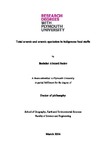Total arsenic and arsenic speciation in indigenous food stuffs
| dc.contributor.supervisor | Hill, Steve | |
| dc.contributor.author | Sadee, Bashdar | |
| dc.contributor.other | School of Geography, Earth and Environmental Sciences | en_US |
| dc.date.accessioned | 2016-05-05T16:08:57Z | |
| dc.date.available | 2016-05-05T16:08:57Z | |
| dc.date.issued | 2016 | |
| dc.identifier | 10357842 | en_US |
| dc.identifier.uri | http://hdl.handle.net/10026.1/4583 | |
| dc.description.abstract |
The properties of an element are highly dependent on its chemical form, it’s called elemental speciation. This study evaluates the arsenic species found in a range of food stuffs together with growing environments and toxicity issues. Total arsenic concentrations in fish tissue and vegetable crops were determined by ICP-MS following microwave-assisted acid digestion using nitric acid/hydrogen peroxide, trypsin and cellulase enzymatic extraction procedures. The extracted arsenic species were then quantified using HPLC-ICP-MS. A dilute nitric acid (1 % (v/v)) digestion procedure was also used to extract arsenic species from rice and the different parts (root, skin, stem, leaf and grain) of a range of plant crops. The study was extended to include the aqua-regia extractable arsenic content of the soils collected from the area where the plants had been cultivated in the Kurdistan region of Iraq. Irrigation water was also investigated, but found to contain low levels of arsenic. An anion-exchange HPLC-ICP-MS method was developed, using sulphate and phosphate, for the separation and quantification of AsB, MMA, DMA, InAsIII and InAsV. The results obtained for fish samples were in the range of 3.53-98.80 µg g-1 (dry weight) with non-toxic AsB being the predominant species. The InAsV concentration was in the range of 0.1-1.19 µg g-1 for all fish species except for the John Dory which was below the limit of detection (0.027 µg g-1). Total arsenic, arsenic species, and total multi-elements (including Ag, Al, B, Ba, Be, Cd, Co, Cr, Cu, Fe, Mn, Mo, Ni, Pb, Sb, Se, Si, Ti, V and Zn) were determined in rice samples from Kurdistan, Iraq and other regions of geographical origin. The transport of arsenic from the soil and irrigation water into roots, stem, leaf and subsequently into the grain or bean of the plants is important when assessing the potential health risks from food crops. For the soil sample, InAsV was found to be the major species with smaller quantities of InAsIII . After applying a full BCR sequential extraction procedure to the soils, it was found that 7.87 - 21.14 % of the total arsenic was present in an easily acid-soluble extractable form. Finally, a novel method was developed to measure total arsenic and arsenic species associated with vegetative DNA. In rice plant, it was found that InAsV incorporated within the DNA molecule in which it could replace phosphate. It was also found that the concentration of InAsV associated with DNA molecule decreased with decreasing total arsenic in the rice plant from the root to the leaf. | en_US |
| dc.description.sponsorship | Ministry of Higher Education and Scientific Research-Kurdistan region of Iraq | en_US |
| dc.language.iso | en | en_US |
| dc.publisher | Plymouth University | en_US |
| dc.subject | Arsenic speciation in food stuffs | en_US |
| dc.title | Total arsenic and arsenic speciation in indigenous food stuffs | en_US |
| dc.type | Thesis | |
| plymouth.version | Full version | en_US |
| dc.identifier.doi | http://dx.doi.org/10.24382/3306 |
Files in this item
This item appears in the following Collection(s)
-
01 Research Theses Main Collection
Research Theses Main


